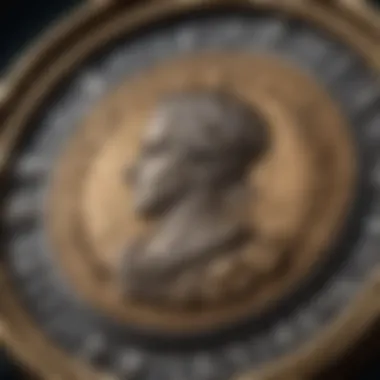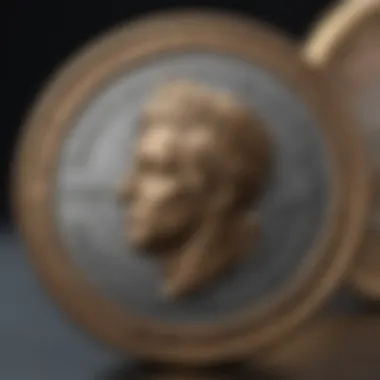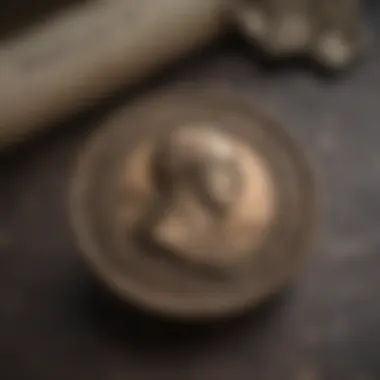Unveiling the Allure of Rare Coins: A Collector's Guide


Intro
Collecting rare coins is an intricate hobby that interlaces history, art, and financial acumen. For passionate collectors and keen investors, it offers more than mere fulfillment of curiosity. Understanding this niche can significantly influence investment choices while allowing individuals to revel in past civilizations and craftsmanship. In this article, we will embark on a deep exploration of valuable coins, their captivating backstories, and prudent investment strategies in this unique field.
Overview of the Topic
Rare coin collecting, often viewed merely as a pastime, carries considerable weight in financial endeavors. The importance of this topic resides in the intrinsic and extrinsic value these coins offer. Many collectors buy rare coins not just for emotional satisfaction but also as alternatives to traditional investments.
Definition and Importance of the Topic
So, what qualifies a coin as 'rare'? Generally, a coin is considered rare when fewer than a certain number exist. Factors include historical relevance, striking errors, and geographic origin. A magnificent example is the 1909-S V.D.B. Lincoln Penny, which is celebrated for its rich lineage and significance, with only a few thousand still in circulation.
This expansive market also reflects economic trends and societal shifts, capturing cultural significance over time. As market dynamics shift, rare coins can appreciate, offering potential gains that accompany this rich history.
Key Benefits and Implications
Investing in rare coins paves the way for several remarkable benefits, such as:
- Investment Diversification: Rare coins act as an asset class distinct from typical stocks or bonds, legislating a hedge against inflation.
- Historical Appreciation: Collectors often find themselves understood the history that surrounds various pieces, which adds additional value to possession of these items.
- Tangible Asset: Physical ownership of coins mitigates certain risks associated with purely digital assets.
However, it is vital to be aware of the potential downsides, such as market fluctuation and authenticity concerns, which individuals need to take into account.
Exploring Strategies and Tips
While diving into the world of numismatics evinces a level of excitement, strategy is essential. Having a well-thought-out approach aids significantly in managing one’s collection both personally and financially.
Practical Tips for Implementation
- Research Extensively: Knowledge is invaluable in this arena. Understanding grading systems insures the value and quality of the coins.
- Build Relationships: Engage with numismatists and attend coin shows to widen your network and gain industry insights.
- Join Collecting Clubs: Delve into the community aspect, gaining awareness of trends and patterns.
Strategies for Effective Management
- Document Thoroughly: Keep meticulous records of purchases, histories, and valuations.
- Regular Appraisals: Evaluate coins periodically to track shifts in market value.
- Store Safely: Ensure coins are appropriately preserved from environmental volumes.
Real-life Examples and Case Studies
One of the notable cases in rare coin collecting is the collection amassed by numismatic genius, Wayte Raymond, few generations ago. His coins followed financial critically, indicating rises and falls in the market side. Many coins from his collection assume exceptional values today.
Thus, collectors must consistently assess market value and not just in favorable times.
Ending
Collecting rare coins melds history, art, and investing, requiring an entrance approach involving research and networking. Through paintings, authenticity checks, and knowledge about each rare coin's tale, the art form takes a serious tone regarding investment opportunities. The more one delves into learning, the stronger the understanding of both coins and their financial statements becomes.
Understanding Coin Rarity and Value
Coin collecting evokes tremendous interest due to the diverse coins and historical significance behind them. Understanding rarity and value is crucial in determining what makes certain coins desirable. This section aims to illuminate what rarity truly means in the context of collecting, as well as explore the myriad factors that influence a coin's market value.
Defining Rarity in Coin Collecting
Rarity in coins primarily relates to how many of a specific coin exist. Lamentably, rarity is not merely about scarcity in number; it entwines with demand from collectors, the history behind each coin, and their condition. A coin with a mintage of only a few units can still be undervalued if demand is low. Hence, rarity is a balance between scarcity and desire.
It is vital for collectors to grasp how rarity is assessed. This can include details such as age, minting errors, and historical significance. For instance, an ancient Roman coin from a prominent emperor is likely to carry more weight than an equivalent coin from an insignificant period.
Here are some factors that often determine rarity:
- Mintage Numbers: Coins produced in low quantities.
- Survivability: Coins lost or damaged significantly reduce the available collectable stock.
- Collector Demand: More people wanting specific coins increase rarity.


Factors Influencing Coin Value
When considering the value of rare coins, several crucial factors surface. Understanding these components can aid both seasoned collectors and newcomers in navigating the intricate world of coin collecting. Here are some influential elements:
- Condition (Grading): The State of a coin significantly affects its price. Coins graded better, like MS-65 or higher, command a premium over lower grades. Soft tissue, wear, and scratches degrade value.
- Market Trends: Currency fluctuations and economic climates also play a large role. For example, collectible action tends to rise during economic recessions.
- Historical Context: Coins tied to important historical moments or remarkable collections tend to embody value significantly beyond their face value.
- Reputation of the Seller: Well-known dealers offer paperwork and verification, boosting credibility for the sold coins and their market rates.
Each of these factors intertwines seamlessly to summarize why rarity plays a paramount role. Collecting rare coins transcends mere possession; it circles history, economy, and the satisfaction that unfolds as one uncovers stories layerd within each coin.
Historical Significance of Rare Coins
The realm of rare coins is not merely about monetary value; it encapsulates a rich narrative of human history, culture, and economic evolution. Each unique piece tells a story, connecting collectors to distinct eras and significant events. Understanding the historical significance of rare coins can enhance the collecting experience, as it turns what might seem like a simple acquisition into a deeper exploration of our shared past.
The Role of Coins in History
Coins have long served as more than just a medium of exchange. They are artifacts that reflect the societies in which they were produced. Coins can illustrate trends, such as shifts in economic power or cultural influence. For instance, ancient coins often showcase deities, leaders, and pivotal battles, providing insight into the values and priorities of that time.
- Economic Indicators: The materials and production methods used can indicate economic stability or turmoil. A poorly made coin might suggest weariness, while a gold coin might reflect opulence and prosperity.
- Cultural Reflection: Coins featuring significant leaders or natural symbols reveal what was held important by a society, allowing collectors and historians to interpret these selections.
- Lines of Trade: The origin of a coin can signify trade routes and exchanges that once existed, contributing to archaeological understanding of globalization in earlier times.
Understanding these roles places rare coins within a broader Historical context, emphasizing thier importance beyond numerical values.
Notable Historical Coins
Certain coins have left indelible marks on history, becoming icons in their own right. Recognizing these notable historical coins can provide collectors with guidance on valuable acquisitions and deeper connections to past moments. Here are a few:
- The Athenian Tetradrachm: Issued by Athens around 500 BC, this silver coin is notable for its intricate design and influence on trade. It is often considered a model for subsequent coinage, shaping economic practices in the Mediterranean.
- The Byzantine Solidus: A gold coin used in the Byzantine Empire, the solidus was prized for its consistency and made a lasting impact on currency in Europe. It demonstrates the stability of Byzantine economy in a turbulent age.
- The Spanish Dollar: Known as the
Categories of Rare Coins
The categorization of rare coins is fundamental to the comprehension of the collecting landscape. Different categories can appeal to various types of collectors based on interest, investment strategy, and budget. Understanding these categories can lead collectors to make informed decisions.
Ancient Coins
Ancient coins hold great historical significance. They include pieces from empires like Greece, Rome, and Persia. The allure of ancient coins lies not only in their age but also their craftsmanship. Each coin tells a story, often showcasing mythology, gods, or significant events. Collectors find value in provenance—knowing where the coin has been and who has owned it.
A few notable examples are:
- The Athenian Owl: A symbol of wisdom and knowledge.
- The Roman Denarius: Used in ancient trade, showcasing remarkable art and inscriptions.
Collecting ancient coins requires care. It is essential to check authenticity and condition, as the market is rife with replicas. Special resources like Numismatic Guaranty Corporation provide expertise on grading these coins.
Medieval Coins
Medieval coins emerged during a transformative period in Europe. They reflect the shift from bartering to monetary systems. This category often includes pieces from dynasties, showcasing royal portraits and crests. They embody both economic and artistic values from their time.
Noteworthy medieval coins include:
- The Gros Tournois: A significant currency during the late Middle Ages.
- The Arab Dinar: Widely used in trade and still influential today.
The appeal of medieval coins includes a connection to history and cultural evolution. Collectors appreciate their rarity and historical context. Knowing proper attribution methods is key to excitement in this venture.
Modern Coins
Modern rare coins represent denominations minted from the late 19th century onwards. They are often more accessible, making them appealing to new collectors. However, numerous modern coins, especially those with errors or limited mintage, can hold tremendous value.
Examples of modern rare coins include:
- The 1909-S V.D.B. Lincoln Penny: Fabled for its limited mintage.
- The 1982 Copper Cent: A transition piece with notable error variation.


Understanding the distinctions in modern coins allows investors to ascent rapidly in the coin collecting market. Knowledge of trends and rarity assures sound investment decisions.
The field of coin collecting is deep and rich with possibilities. Each category, from ancient to modern, opens doors to investment and knowledge that can last a lifetime.
Categorizing rare coins is essential for anyone looking to collect thoughtfully. Each type offers connectivity with history and investment opportunity, promoting consideration and dedication in the collecting process.
Iconic Rarest Coins
The realm of rare coin collecting is garnished with remarkable specimens that bear witness to economic history, artistry, and innovation. Each coin tells a story and encapsulates its time’s values and conditions, which is why these iconic rare coins have considerable allure to collectors and investors alike. Understanding the iconic nature of these coins is crucial. They enhance the collector’s portfolio not only through aesthetic appreciation but also in investment value. Each unique coin carries nuances that may appeal to both seasoned and beginner collectors.
The St.
Gaudens Double Eagle
The 1933 St. Gaudens Double Eagle is perhaps the most celebrated gold coin in American numismatics. Minted at a time when the Gold Standard fell apart and pushed the United States towards a more flexible currency paradigm, it is emblematic of the nation’s transition in financial systems. Only a handful of these coins were released into circulation before being ordered to be melted down due to the Gold Reserve Act of 1934.
Collectors value the 1933 St. Gaudens Double Eagle not just for its historical context but also for its aesthetic beauty. Augustus Saint-Gaudens designed it with a striking portrayal of Lady Liberty on the obverse and a majestic eagle soaring on the reverse. The artistry is often regarded as one of the highest achievements in coin design. As exchanges flow, its auction record beckons the impressiveness of how a single piece of money can trade for millions. On average, the last legitimately sold example fetched a price exceeding $7 million, showcasing how investments in rare coins can yield substantial revenues.
The 1909-S V.
D.B. Lincoln Penny
With just over 484,000 minted, the 1909-S V.D.B. Lincoln Penny captures the essence of scarcity in numismatics. Created to commemorate the one hundredth anniversary of Abraham Lincoln's birth, this coin bears the initials of engraver Victor David Brenner on the reverse. Soon after its release, the V.D.B. name sparked controversy, leading to mint officials pulling many from circulation.
This coin, with its distinct position in the American coin series, typically commands high prices in the collectors market with uncirculated examples selling for tens of thousands of dollars. Investors see it as not only a piece of currency but also an institutional artifact representing the values and opinions of its time. Additionally, due to its popularity, it remains a gateway for novice collectors eager to step into the more profound world of coin collecting.
The Flowing Hair Dollar
Introduced in the late 18th century, the Flowing Hair Dollar transports patrons to the early days of the United States. Made between 1794 and 1795, it is one of the first silver coins struck by the U.S. government and features a depiction of Liberty with flowing hair. Only a limited number of coins were produced, making it hugely sought after by collectors. The American dollar system emerged sizably during this transformative era.
Rarity instills a significant value—one 1794 Flowing Hair Dollar set a record for selling for over $10 million. Possession of this coin is not only about utility but also an evocation of national pride and cultural heritage adherence. Within the collector's circle, it’s often viewed as an artifact with historical significance far beyond its silver content.
The Silver Dollar
Commonly known as
Collecting Strategies for Rare Coins
Collecting rare coins involves much more than simple appreciation for history or aesthetics. It encompasses strategic thinking and informed decision-making. A well-crafted strategy not only increases the chances of acquiring valuable coins but also guides collectors away from potential pitfalls. The interplay of technique, information, and networking forms the backbone of successful coin collecting. Each aspect contributes to both the enjoyment and the financial viability of assembling a rare coin collection.
Research and Networking
Research is the first pillar of any effective coin collecting strategy. Knowledge about specific coins, denominations, and historical significance is crucial. One must understand rarity and what makes certain coins desirable to other collectors. Advanced research includes studying coin grading standards and the nuances of market trends.
Networking enhances research efforts. Engaging with other collectors expands resources for information. Platforms like Reddit can foster meaningful connections with fellow enthusiasts. Here, individuals can share insights and literature, enhancing collective knowledge. Local coin clubs serve a similar function by offering events where members discuss rare coins, trade artifacts, and access to quality educational materials.
In summary, knowledge is power in the realm of rare coins. Active research and sincere networking provide a strong foundation.
Attending Coin Shows and Auctions
Coin shows and auctions represent vital environments for collectors. Attending these events offers direct interaction with coins and enthusiasts. Collectors have the opportunity to physically examine the condition of coins, which is often more revealing than photographs.
The benefits are clear: At coin shows, collectors can interact with dealers, mixers, and fellow collectors face-to-face. Here, queries about unique pieces can often lead to a discount or position at priority lists for purchases. Auctions, meanwhile, provide them chance to secure rare pieces competitively. Understanding the auction process is essential to avoid overbidding; strategic restraint is always a smart approach.
Additionally, collectors can keep up to date on market fluctuations and trends at these events. The insight gained can significantly influence future purchases and collection strategies.
Utilizing Online Marketplaces


In the digital age, online marketplaces present one of the most effective means for purchasing rare coins. Websites such as eBay and auction-specific sites facilitate access to a wide range of collectible coins. An understanding of user ratings and seller history should always dictate buying decisions to ensure the authenticity of items.
One distinct advantage of online platforms is the availability of global selections. Collectors can discover coins from regions far beyond their local availability. Some specialized marketplaces even offer services to should a degree of coins expertise, providing appraisals and grading insights along the way.
Despite their benefits, online marketplaces do require caution. The risk of counterfeit coins or inflated pricing exists here as well. Researching market values and maintaining clear communication with sellers are paramount practices for navigating these platforms successfully.
Collecting rare coins is an intricate blend of knowledge, strategy, and community interaction. Each of these elements enhances the collector’s experience, enriching the purposeful pursuit of both rarity and potential investment value.
Assessing the Investment Potential
Assessing the investment potential in rare coin collecting is an essential aspect for collectors and investors alike. With the increasing interest in rare and valuable coins, understanding the potential financial return can provide guidance on making informed decisions. Commodities like rare coins can often hold significant monetary value due to their scarcity and historical significance. By examining risks, long-term value appreciation, and market trends, collectors can position themselves better within the various complexities of the numismatic landscape.
Risks Associated with Coin Collecting
Like any investment, coin collecting comes with its share of risks. Enthusiasts may face forgery, fluctuating prices, and potential market volatility.
- Forged Coins: The market has counterfeit coins that mimic genuine pieces closely. It is crucial to verify the authenticity of a coin through proper channels.
- Market Fluctuations: The value of rare coins can depend heavily on market conditions and buyer demand, which can vary significantly over time.
- Lack of Knowledge: Inexperience can lead to purchasing coins that do not hold the expected value or that lack historical significance.
It's vital to conduct thorough research before making purchases and regularly manage and reassess collections to mitigate these risks. Partaking in community forums or engaging experts can assist significantly.
Long-Term Value Appreciation
Considering the long-term value appreciation of rare coins is an imperative part of any collecter's investing strategy. Historical pieces often accumulate value over time, especially those with unique features or compelling backstories. Factors to consider include:
- Rarity and Demand: Coins that have a compelling narrative or flaws in their initial minting process tend to command a higher price. For example, limited production coins or varieties contribute to their allure.
- Investment Horizon: Rare coins can serve as a long-term investment. Unlike stocks or bonds, collectible coins do not usually follow the same economic cycles and can experience enduring value growth.
- Market Trends: Staying informed on market conditions enables collectors to understand economic impacts on the desirability of specific coins. Historic economic downturns may lead collectors to seek tangible investments, increasing coin demand.
Consistency in keeping abreast of historical importance and market dynamics enhances one’s potential for long-term investment rewards. Therefor, rare coin collecting can be more than a hobby; it potentially can be a wise investment strategy supporting one’s financial world.
In the volatile world of investments, rare coins offer both risks and significant potential rewards when approached wisely.
Preservation and Care of Rare Coins
Caring for rare coins requires a nuanced approach. Their intrinsic value and condition can significantly diminish if proper preservation techniques are not applied. The act of handling, storing, and maintaining these coins can be as crucial as the act of collecting them in the first place.
Proper Handling Techniques
Handling rare coins with care is the first line of defense against wear and tear. Ideally, collectors should employ specific techniques to prevent physical damage. Here are some essential methods:
- Always hold coins by the edges. This practice minimizes the risk of fingerprints or smudge marks.The oils from human skin can degrade a coin’s surface over time.
- Utilize soft cotton or latex gloves during handling. This creates a barrier between your skin and the coin, helping prevent both oils and dirt from transferring.
- Avoid using cleaning methods that involve liquids or aggressive substances. Professional investors agree that cleaning can invariably result in loss of value. Coin surfaces can be easily corroded or affected by amateur cleaning treatments.
- When passing a coin, make sure it remains in its holder or container until the instant of observation. Ensure hand positions securely envelop the coin without excess movement.
In summary, proper handling is an umbrella of numerous small practices, any of which can protect your valuable collections for many years.
Storage Solutions for Rare Coins
Storing rare coins properly is also a necessary part of their preservation. Just having proper handling is not enough in the face of time. Here, several storage solutions promise protection and long-term condition maintenance:
- Use coin holders such as albums, tubes, or capsules designed specifically for secure storage. These allow air circulation while preventing scratch edges and mishaps.
- Consider climate control. Coins should be stored in environments that don't undergo major temperature or humidity shifts. Excessive moisture could potentially lead to tarnishing or corrosion over time.
- An encrypted saved vault or safety deposit box gives an extra layer of security. Particularly for coins of exceptional value, security measures should equal the nature of their risk.
“Proper preservation not only maintains the coin in prime condition but also supports its market value over time.”
Taking these considerations into account highlights the distinctions of each method aimed at extending the life of a rare coin collection. Investing time and knowledge in preservation further allows collectors and investors alike to safeguard not merely financial gains but also their passion for the arts of numismatics.
Culmination: The Essence of Rare Coin Collecting
Rare coin collecting goes beyond the simple accumulation of currency or artifacts. It embodies a pursuit of history, art, and investment all in one. As discussed throughout this article, rarity signifies not just the number that may exist, but also the historical stories that these coins carry. Throughout history, each coin signifies a moment in time, allowing collectors to own pieces of the past.
Understanding the nuances of rarity encourages collectors and investors to make informed decisions. The journey of coin collecting is filled with learning and networking opportunities that can lead to meaningful relationships in this niche. Strategies to maintain and grow a collection also underscore the significance of wise investments.
The appraisal of coins, both in historical context and market potential, further illustrates why this topic is of significance. From examining different classification categories to delving into notable examples — such as the 1933 St. Gaudens Double Eagle or the 1909-S V.D.B. Lincoln Penny — every coin adds richness to a collection, thus enhancing its cumulative value over time.
Collectors should also pay heed to preservation tactics. Ultimately, a well-preserved coin not only possesses retainable value but can appreciate in the long season of ownership. Coin collecting allows one to engage with both the aesthetic qualities of the coins themselves and their underlying financial potentials.
“The essence of rare coin collecting lies in the unmatched combination of history and investment. A great coin collection can tell whole stories of chapters in time.”



